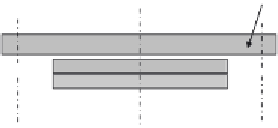Civil Engineering Reference
In-Depth Information
Top plate
Piston (with PTFE
bonded on top)
Sliding plate
(stainless steel)
Bottom plate
Elastomer
Figure 3.41 Pot bridge bearings.
a sliding element to accommodate translational movements in one or any
direction. This can be achieved by a PTFE (polytetrafluoroethylene)/stain-
less steel interface, usually arranged as shown in
Figure 3.41
.
The coefficient
of friction on the sliding surface depends on the PTFE interface pressure and
is typically 5%. Pot bearings may be fixed, or guided, by providing suitable
lateral restraints between the top and bottom plates. Proprietary elastomeric
bearings may be of strip, rectangular pad, or laminated type. Laminated elas-
tomeric bearings (see
Figure 3.42
)
are economic for loads up to 1000 kN
capacity. For loads greater than 1000 kN, the bearings may become uneco-
nomically large. Therefore, elastomeric bearings are rarely used for steel
highway or railway bridges. The design of elastomeric bearings is governed
by serviceability limit state requirements, to control excessive distortion of
the material. Movements and rotations are achieved by deformation of the
elastomeric material (see
Figure 3.43
). Movement is restricted to about
40 mm from the mean position.
Proprietary cylindrical bearings consist of a backing plate with a convex
cylindrical surface (rotational element) and a backing plate with a concave
Figure 3.42 Laminated elastomeric bridge bearings.























Search WWH ::

Custom Search